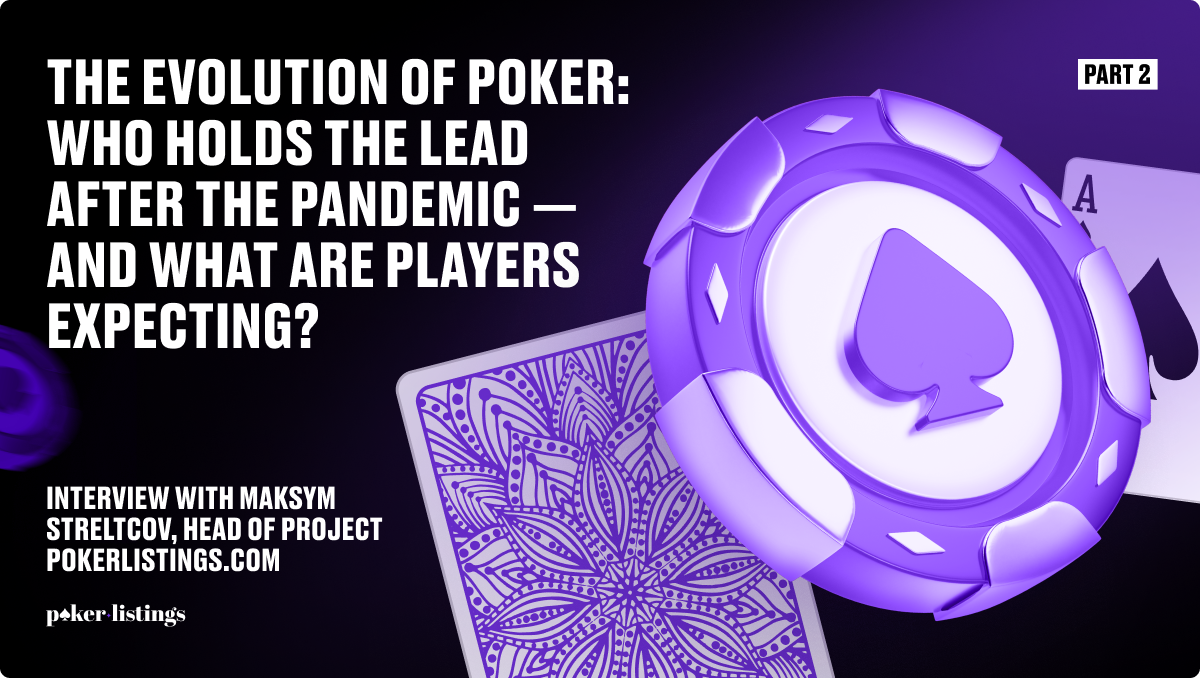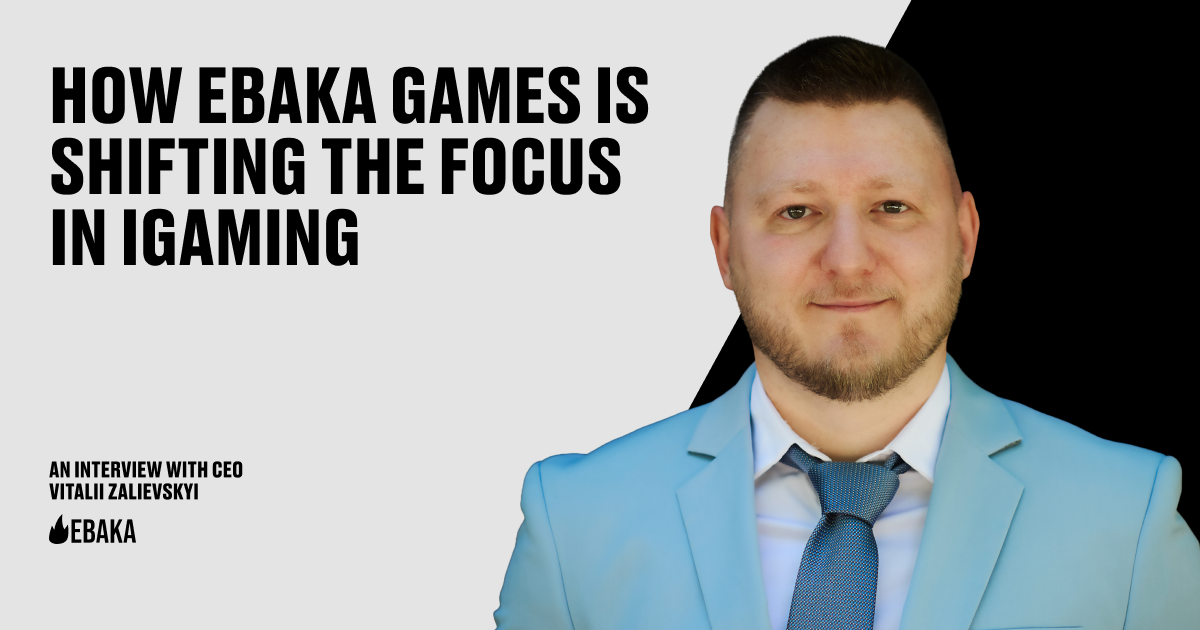
We continue the conversation about the future of online poker in a new Expert Talks episode, focusing on the key trends shaping the industry today. Why couldn’t poker rooms sustain the peak popularity they saw during the COVID-19 pandemic? How are technologies changing player behavior and approach? What challenges do operators face in different regions? Max Streltcoff, Head of Project at PokerListings.com, explains how brands are adapting to these shifts and building new strategies.
The Pandemic and the Digital Surge
How did COVID-19 affect live and online poker? What changed in player behavior?
The COVID-19 pandemic became one of the major global events that impacted the industry. On the one hand, people faced limits on in-person interaction; on the other, 53% of the world’s population already had stable internet access (as of 2019). That created ideal conditions for online poker’s 2020 surge comparable in scale to the legendary “Black Friday” of 2011. Poker rooms capitalized smartly: they increased ad budgets and aggressively attracted new audiences. Unfortunately, for many the success was short-lived. The spike lasted only a few months, after which interest returned to previous levels.
Why did that happen? If you’ve ever tried to start a diesel car in freezing weather, you know the moment when the starter is just about to turn the engine over, but then everything stalls and you have to try again. That’s essentially what happened to online poker during COVID-19: a sharp surge, the hope of “second wind,” and… back to square one. More importantly, the pandemic reshuffled the balance of power inside the industry. GGPoker overtook PokerStars and began setting its own records. The room partnered to host WSOP Online, and later in October 2024 acquired exclusive rights to run the entire WSOP. That marked a definitive change of leadership.
So did the pandemic become a “second wind” for online play?
Interest in online poker did spike dramatically, but most rooms couldn’t convert the moment into long-term retention. The industry didn’t experience a true “reboot” like during the Moneymaker effect; sustained, steady growth didn’t materialize. It was a short-term jump that accelerated a leadership change amid stagnation rather than breathing new life into the market.
What Tech and Formats Emerged Next?
Over the past decade, poker rooms have actively experimented with mechanics and new approaches. For example, fast-fold poker (first implemented as Rush Poker on Full Tilt) eliminated downtime between hands: fold your cards, instantly move to a new table. That let players see more hands per minute and made poker convenient on smartphones—kick-starting the shift to mobile. Later, Winamax and then PokerStars pushed Spin & Go tournaments: three players, one winner, prize pool determined at random. Anyone can register for $5 and play for a million an ideal ad format. Economically, it’s also efficient for rooms: no need for marathon tournaments with tens of thousands of entries, and the rake is essentially built into the probability of large prizes.
Bottom line: online poker evolved toward speed, simplicity, and mobility.
Post-COVID, these trends only intensified. More players use smartphones, and formats are edging closer to casino-style dynamics. For instance, All-in or Fold offers only two actions, making play fast, aggressive, and volatile. Experiments with AI are gaining visibility, too some test modes where an algorithm makes decisions for the player, but at the final table the human can “take over” and finish the game.
For now, such tech remains niche and often raises concerns among players. COVID also triggered a mass migration of live series online. In 2020, large offline tournaments launched online versions, and the experiment worked. Today, WSOP Online is an annual event. On one hand, that dilutes the uniqueness of the bracelet; on the other, it makes it accessible to a broader audience. I believe the trend toward major online series will continue, and collaborations between live brands and online rooms will only strengthen. It’s a classic win-win.
The New Reality: Regulation, Data, Trust
How is poker regulation changing especially in Europe and Asia?
In 2006, the UIGEA passed in the U.S., effectively shuttering the country’s online-poker industry. Since then, there’s been a slow, 19-year process of incremental legalization: some states allow online play, others issue licenses, and some have begun pooling players across state lines. It’s a bottom-up path from regions to federation.
In Europe, it’s the opposite. At the EU level, online poker isn’t banned, but each country imposes its own (often restrictive) regulations, and the differences can be significant. In the Netherlands, for example, players aged 18–23 may legally play, but promoting bonuses to them is prohibited. Nearly all markets require local licenses, which can be economically unappealing for international brands given relatively small player pools. As a result, instead of becoming a growth zone, Europe has turned into a complex, fragmented region for the industry.
At the same time, Latin America, Asia, and Africa are becoming promising new markets, but regulation is ramping up there as well. In Brazil, for instance, legislators have already drafted acts regulating online poker separately from casino. There’s a strong chance the approach will spread to neighboring countries. In Asia, the situation is tougher. In many countries, online poker is formally prohibited and pushed underground bad for rooms, players, and governments. In my view, bans only make things worse: they don’t solve the problem, they just move it into an unregulated space.
What’s changed in transparency and oversight? How does this affect affiliates and poker rooms?
After scandals like the super-user cases at Absolute Poker and UltimateBet, regulation tightened noticeably. Licensing bodies more actively fine rooms for violations. RNGs must be tested by independent auditors. In Europe, strict GDPR rules also affect everyone’s operations. Yet gray areas remain. For example, no external party can guarantee whether a room allows bots or not. Despite formal rules, the industry still largely hinges on brand reputation and player trust in specific rooms and affiliates.
For affiliates, tighter rules have also made work more complex. There are time-of-day restrictions on advertising, greater difficulty using and processing user data, and stricter terms from the rooms themselves: bans on self-run promos, reduced rakeback, limited ad channels. The affiliate’s role is now less autonomous and more dependent on the partner program’s rules.
How acute is the trust issue in poker now? How do players verify a room’s fairness?
Rumors that “the RNG is rigged” appeared alongside online poker itself and haven’t gone away. Players tend to blame losses on anything but their own decisions and the room, as the intermediary, becomes the main suspect. Even if a project openly publishes its license, posts an RNG certificate, and provides a complaint mechanism, some players still refuse to believe in independence and transparency. That’s a perception problem, not a lack of evidence.
In my experience, it’s almost impossible to convince someone that losing with pocket aces wasn’t “fixed.” Even if aces are 85% to win all-in versus a random hand, the remaining 15% still happens. And that loss is what the player remembers not the many hands where aces held. Often it’s simpler for such a player to switch platforms and start fresh until they again encounter a loss that’s easier to blame on anyone but themselves. It’s understandable, though: the audience has virtually no tools to verify fairness beyond relying on licenses and brand reputation. Attempts to introduce alternatives like blockchain hand verification didn’t really take root in the industry.
PokerListings’ Role: Adapting to the New Landscape
How is PokerListings adapting to modern industry changes? What are your focus areas now?
Remember Avis’s “We try harder” campaign? As the second-largest car-rental brand, it said it had to work harder than the leader. At PokerListings, we take a similar view: we aim to be one technological step ahead to strengthen our position. On one hand, we can afford bolder, more flexible decisions than the biggest players. On the other, we have a long-term roadmap unlike smaller projects that operate without a strategy. Right now, we’re actively building AI tools for data analysis and structuring, providing human support to users not chatbots, but real specialists. We’re also preparing new offerings for affiliates, who are often overlooked by larger brands. We keep a wide-angle view of the industry and look for opportunities others miss.
What are you implementing in the product to stay ahead? What has already changed recently?
We began the project reboot when it needed serious technical work. The first six months were spent cleaning up under the hood: synchronizing and stabilizing a network of interconnected sites. After that, we refreshed the branding to lock in the changes and signal that PokerListings is moving in a new direction. Next, we started shipping features that match real user needs. First came a freerolls section primarily for beginners. We created a dedicated sub-team for ingesting room data and signed agreements with several rooms to provide the necessary information. For casual users, we launched a quizzes section, a lightweight, interactive way to learn, rather than through long-form articles. This month, we rolled out a major U.S. section: an interactive map shows the regulatory status of online poker in each state, with deep-dive links to local laws, licensed brands, regulator contacts, and more.
The next step is integrating media content directly into the main platform. Right now it lives separately, but we want everything under one roof so users can access information, news, and analytics in a single place. By late summer, we plan to launch a new traffic-data service for poker rooms, with real, regularly updated numbers and a level of granularity the industry hasn’t seen before.
In our previous interview you said you aim to be as “white” (compliant) as possible. What are you doing on that front?
I think our legal team has tripled since last time. Today they review every product change to make sure that, in pursuit of growth, we don’t cross regional legal lines which are becoming more complex and less predictable every month. We deliberately avoid many fast and convenient solutions that regulators might dislike down the line. This approach doesn’t pay off immediately, but we plan to stay in the industry for the long haul. So we chose a strategy that may not be the fastest, but is safer over distance.
Technology continues to push online poker forward, making the game more dynamic and accessible. This also changes audience expectations: players increasingly choose faster formats and seek new experiences. Not every innovation sticks especially if it doesn’t deliver real value. AI is already helping rooms personalize offers and helping players develop their skills. But trust still comes first. Even with independent algorithms, transparency isn’t guaranteed and reputation remains a project’s most important asset.
In this environment, market leaders can’t afford to lose focus. Many rooms surged during the pandemic, but competition is intensifying, and younger, ambitious projects are closing the gap. In a market where the player always has a choice, every poker room’s job is to do everything possible so that the choice falls in its favor.

